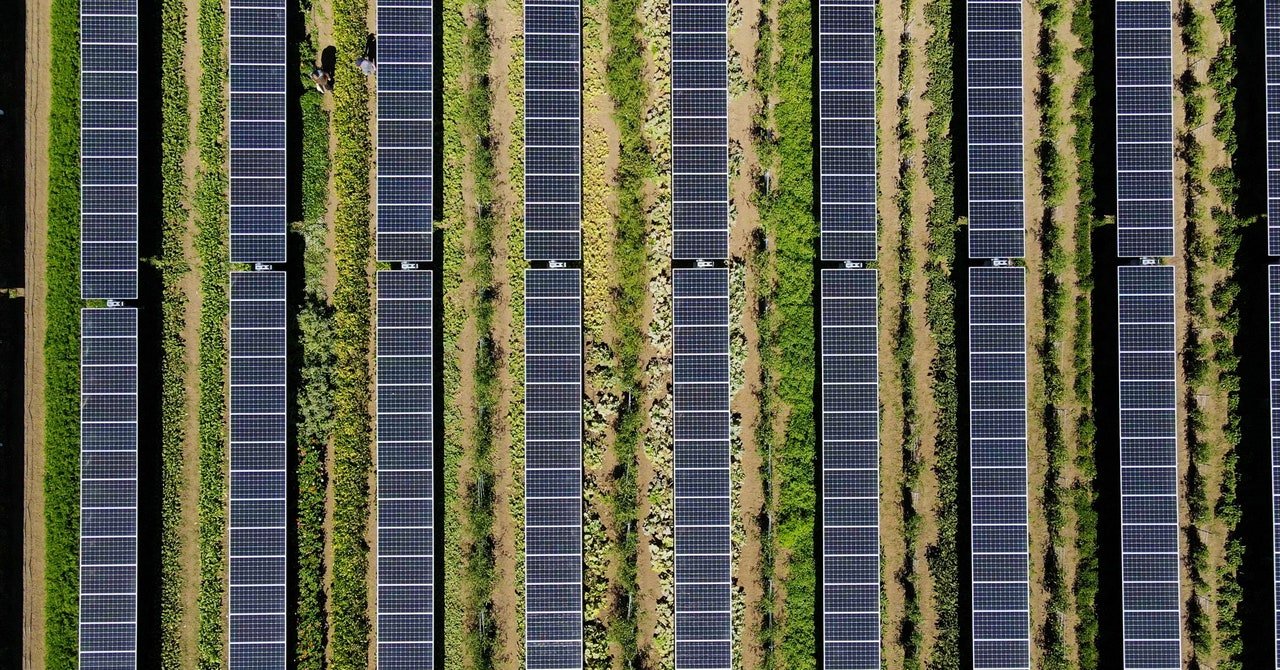Growing Crops Under Solar Panels? Now There’s a Bright Idea
[ad_1]
Heavy precipitation that can damage crops is also on the rise, since a warmer atmosphere holds more moisture. “In times when there is extreme heat or extreme precipitation, by protecting plants in this manner, it can actually benefit them,” says Madhu Khanna, an economist at the University of Illinois, Urbana-Champaign, who also won funding from the USDA’s new agrivoltaics grant. “So that’s another factor that we want to look at.”
Khanna will be studying what the ideal solar array might be for a particular crop, for instance, if it needs bigger or smaller gaps between panels to let sunlight pass through. Height, too, is an issue: Corn and wheat would need taller panels, while shrubby soybeans would be fine with a more squat variety.
Thanks to those gaps, crops grown under solar panels aren’t bathed in darkness. But, generally speaking, the light is more diffuse, meaning it’s bouncing off of surfaces before striking the plants. This replicates a natural forest environment, in which all plants, save for the tallest trees, hang out in the shade, soaking up any sunbeams that break through.
Barron-Gafford has found that a forestlike shading under solar panels elicits a physiological response from plants. To collect more light, their leaves grow bigger than they would if planted in an open field. He’s seen this happen in basil, which would increase that crop’s yield. Barron-Gafford has also found that the pepper Capsicum annuum, which grows in the shade of trees in the wild, produces three times as much fruit in an agrivoltaic system. Tomato plants also grow more fruit. This is likely due to the plants being less stressed by the constant bombardment of sunlight, to which they’re not evolutionarily adapted.
But every crop is going to be different, so scientists have to test each to see how they react to shade. “For example, we probably wouldn’t recommend that somebody plant summer squash directly in the deepest shade, directly under a panel,” says Mark Uchanski, a horticultural scientist at Colorado State University who’s studying agrivoltaics and tested that exact scenario. “The better location for that might be further out toward the edges where it’s more likely to get a little bit more sun, because we did see a yield decrease in that case.”
While setting up the panels entails some up-front costs, they might actually make farmers some money, as Kominek told Grist in this 2020 story before his panels were in place. They’d produce energy to run the farm, and the farmer can sell any surplus back to a utility. And since some plants—like those salsa ingredients in Barron-Gafford’s experiments—will use less water, that can reduce irrigation expenses. “If we can actually allow farmers to diversify their production and get more out of the same land, then that can benefit them,” says Khanna. “Having crops and solar panels is more beneficial for the environment than solar panels alone.”
This kind of setup also cools the solar panels in two ways: Water evaporating from the soil rises up towards the panels, and plants release their own water. This is dandy for the panels’ efficiency, because they actually perform worse when they get too hot. They generate an electric current when the sun’s photons knock electrons out of atoms, but if they overheat, the electrons get overexcited and don’t generate as much electricity when they’re dislodged.
[ad_2]
Source link

